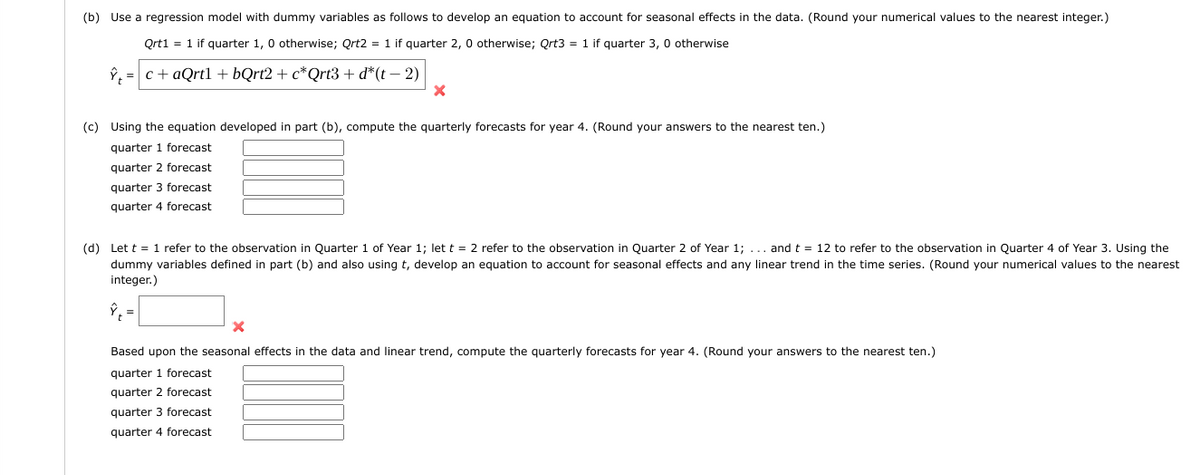(b) Use a regression model with dummy variables as follows to develop an equation to account for seasonal effects in the data. (Round your numerical values to the nearest integer.) Qrt1 = 1 if quarter 1, 0 otherwise; Qrt2 = 1 if quarter 2, 0 otherwise; Qrt3 = 1 if quarter 3, 0 otherwise ŷ, c+aQrtl + bQrt2 + c*Qrt3 + d*(t-2) X (c) Using the equation developed in part (b), compute the quarterly forecasts for year 4. (Round your answers to the nearest ten.) quarter 1 forecast quarter 2 forecast quarter 3 forecast quarter 4 forecast (d) Let t = 1 refer to the observation in Quarter 1 of Year 1; let t = 2 refer to the observation in Quarter 2 of Year 1; ... and t = 12 to refer to the observation in Quarter 4 of Year 3. Using the dummy variables defined in part (b) and also using t, develop an equation to account for seasonal effects and any linear trend in the time series. (Round your numerical values to the nearest integer.) = Based upon the seasonal effects in the data and linear trend, compute the quarterly forecasts for year 4. (Round your answers to the nearest ten.) quarter 1 forecast quarter 2 forecast quarter 3 forecast quarter 4 forecast
(b) Use a regression model with dummy variables as follows to develop an equation to account for seasonal effects in the data. (Round your numerical values to the nearest integer.) Qrt1 = 1 if quarter 1, 0 otherwise; Qrt2 = 1 if quarter 2, 0 otherwise; Qrt3 = 1 if quarter 3, 0 otherwise ŷ, c+aQrtl + bQrt2 + c*Qrt3 + d*(t-2) X (c) Using the equation developed in part (b), compute the quarterly forecasts for year 4. (Round your answers to the nearest ten.) quarter 1 forecast quarter 2 forecast quarter 3 forecast quarter 4 forecast (d) Let t = 1 refer to the observation in Quarter 1 of Year 1; let t = 2 refer to the observation in Quarter 2 of Year 1; ... and t = 12 to refer to the observation in Quarter 4 of Year 3. Using the dummy variables defined in part (b) and also using t, develop an equation to account for seasonal effects and any linear trend in the time series. (Round your numerical values to the nearest integer.) = Based upon the seasonal effects in the data and linear trend, compute the quarterly forecasts for year 4. (Round your answers to the nearest ten.) quarter 1 forecast quarter 2 forecast quarter 3 forecast quarter 4 forecast
Practical Management Science
6th Edition
ISBN:9781337406659
Author:WINSTON, Wayne L.
Publisher:WINSTON, Wayne L.
Chapter13: Regression And Forecasting Models
Section13.4: Multiple Regression Models
Problem 17P: The owner of a restaurant in Bloomington, Indiana, has recorded sales data for the past 19 years. He...
Related questions
Question
Please help with correct answers in details: step by step as last submission were given incorrect answers
A statistical program is recommended.
The quarterly sales data (number of copies sold) for a college textbook over the past three years follow.
| Quarter | Year 1 | Year 2 | Year 3 |
|---|---|---|---|
| 1 | 1,690 | 1,800 | 1,850 |
| 2 | 940 | 900 | 1,100 |
| 3 | 2,625 | 2,900 | 2,930 |
| 4 | 2,500 | 2,360 | 2,615 |

Transcribed Image Text:(b) Use a regression model with dummy variables as follows to develop an equation to account for seasonal effects in the data. (Round your numerical values to the nearest integer.)
Qrt1 = 1 if quarter 1, 0 otherwise; Qrt2 = 1 if quarter 2, 0 otherwise; Qrt3 = 1 if quarter 3, 0 otherwise
ŷ, c+aQrtl + bQrt2 + c*Qrt3 + d*(t-2)
X
(c) Using the equation developed in part (b), compute the quarterly forecasts for year 4. (Round your answers to the nearest ten.)
quarter 1 forecast
quarter 2 forecast
quarter 3 forecast
quarter 4 forecast
(d) Let t = 1 refer to the observation in Quarter 1 of Year 1; let t = 2 refer to the observation in Quarter 2 of Year 1; ... and t = 12 to refer to the observation in Quarter 4 of Year 3. Using the
dummy variables defined in part (b) and also using t, develop an equation to account for seasonal effects and any linear trend in the time series. (Round your numerical values to the nearest
integer.)
=
Based upon the seasonal effects in the data and linear trend, compute the quarterly forecasts for year 4. (Round your answers to the nearest ten.)
quarter 1 forecast
quarter 2 forecast
quarter 3 forecast
quarter 4 forecast
Expert Solution
This question has been solved!
Explore an expertly crafted, step-by-step solution for a thorough understanding of key concepts.
This is a popular solution!
Trending now
This is a popular solution!
Step by step
Solved in 1 steps

Recommended textbooks for you

Practical Management Science
Operations Management
ISBN:
9781337406659
Author:
WINSTON, Wayne L.
Publisher:
Cengage,

Practical Management Science
Operations Management
ISBN:
9781337406659
Author:
WINSTON, Wayne L.
Publisher:
Cengage,